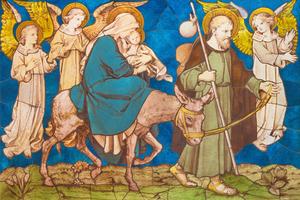Jesus Christ Is Alive, and His Church Draws Her Life From Him
The enduring nature of Catholic doctrine is a testament to its timelessness and truth.

Proponents of scientism often boast of the superiority of science over other systems of thought, especially religious, philosophical and theological systems, because science is self-correcting over time in its nature. In other words, because of the way science works, it eventually finds truth; other systems of thought are susceptible to dogmatic stagnation in error and superstition.
One of the missing pieces from this puzzle is specifically how new ideas succeed old ones among the scientists. In particular, new ideas gain life because old scientists die.
When the question about the possibility of black holes was raised in light of Einstein’s theory of general relativity, the two leading public figures of science denied their possibility. Albert Einstein and Sir Arthur Eddington both claimed that things like black holes were not possible. When a young Indian doctoral student named Subramanyan Chandrasekhar (after whom the Chandra X-ray telescope is named) wrote a paper proving that black holes were possible, he faced backlash and ridicule. Chandrasekhar wanted to publicly challenge his detractors, but his advisor warned him that most people wouldn’t understand his proof anyway. The best thing would be to wait until Eddington and other old scientists died, and the younger generation would champion his ideas. And that’s what happened.
Biologist Thomas Seeley wrote
Many have noted that new and better ideas succeed in scientific debates through attrition, that is, by one generation of scientists retiring from their field and eventually dying off. But before this generation drops from the debate, the next generation of scientists will have listened carefully to the various arguments made by their predecessors, been persuaded by the most compelling claims on the truth, and adopted the new theory.
The famous and influential physicist Max Planck wrote:
A new scientific truth does not triumph by convincing its opponents and making them see the light, but rather because its opponents eventually die, and a new generation grows up that is familiar with it.
By this standard, the ideas that hold up to the test of time are very likely to be true. If confidence is placed in science because it does change from generation to generation, what can be said about a collection of dogmas that endures for 2,000 years? Yes, the ideas have developed and grown, as a tree or any other organic thing matures over time, but the fundamental dogma and structure of the Church have not been overthrown for two millennia. Perhaps Jesus knew what he was talking about when he said that the gates of hell would not prevail against the Church founded on Peter.
The Italian renaissance writer, Giovanni Boccaccio, wrote a story about a wealthy Jewish man from Paris who refused to join the Catholic Church even after many discussions with his Catholic friends and fellow merchants. When the man decided to investigate by going to Rome, his friends despaired, thinking that he would definitely reject the faith when he saw the corruption and depravity of the leadership there. But when he returned to Paris, he joined the Church and declared that she must be founded on the Holy Spirit because any organization run by such depraved individuals should have dissolved many centuries ago — but the Church, instead, thrives and grows.
In contrast to the succession of new scientific ideas, the classics are those works that endure because of their universal impact, because of their truth, beauty and goodness. When a work or set of ideas in the humanities survives without being overthrown, it is an indication of its timelessness (as I have written about here).
In reference to the United States, Abraham Lincoln repeated in his first inaugural address that “the Union is perpetual.” So Christ prayed for and prophesied about his Church, that “they would be one” and that he would be with us even until the end of the Age. So we confess in the Creed: “I believe in one, holy, catholic and apostolic Church.” True unity implies perpetuity. The lasting nature of the Catholic Church, far from being evidence against her, is strong evidence of her truth, unity and inspiration.

















